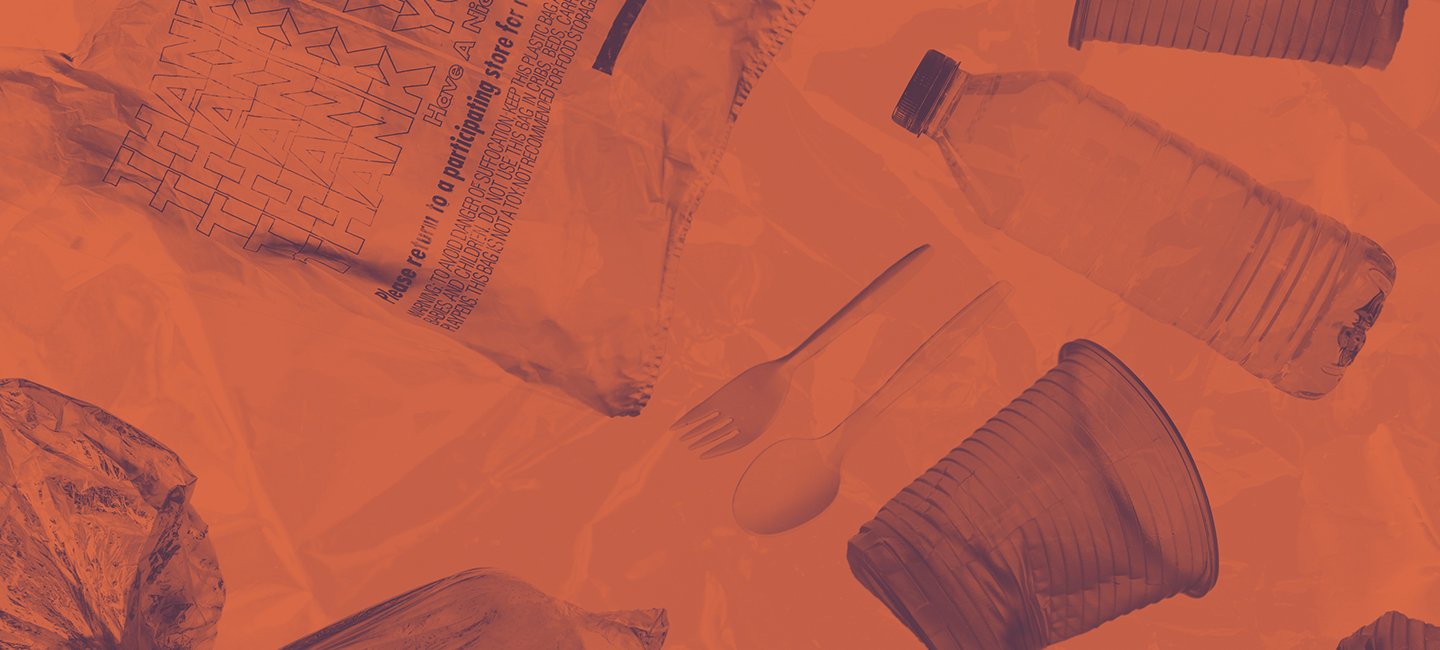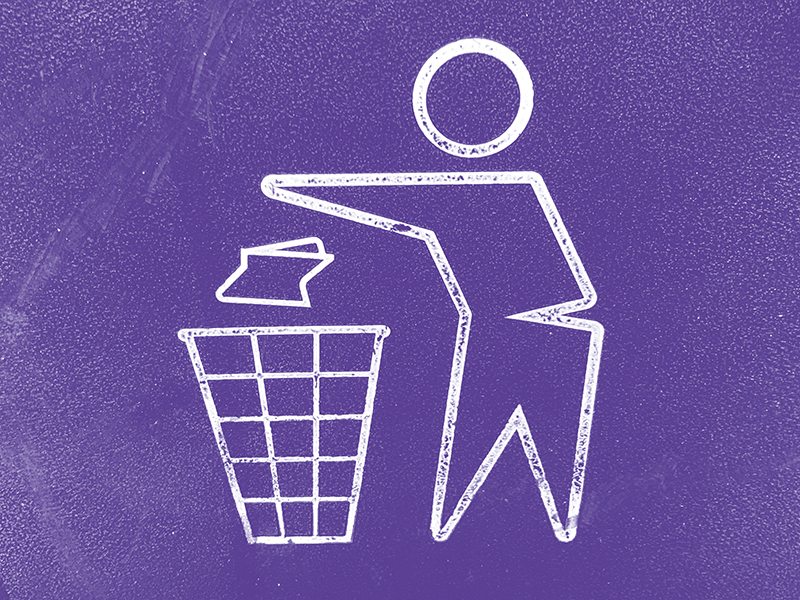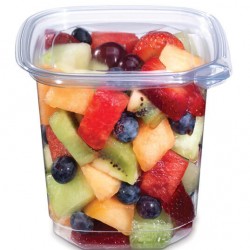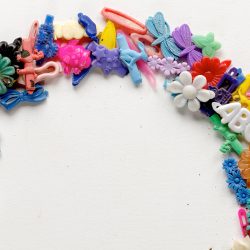
Reclaiming Recycling
UW research may solve the plastics problem that menaces the planet.
It’s lunchtime in Madison. You head down to State Street for takeout and buy a sandwich wrapped in a plastic film, along with a salad in a hard plastic tray. When you finish, you look around for somewhere to dispose of your packaging. You spot a pair of bins, one for trash, one for recycling.
Which bin should you use? What will happen to each of your items after you make your choice? Researchers at the UW have some advice about what to do today — and a strong vision for how we’ll handle plastic waste differently in the near future.
Thanks to a new, multi-institution plastic upcycling center housed on campus, UW experts are poised not only to revolutionize our ability to recycle plastics, but also to launch a major new economic opportunity for Wisconsin’s $2.3 billion plastics-packaging industry.Am
Launched in 2020 with a $10 million grant from the U.S. Department of Energy, the Chemical Upcycling of Waste Plastics (CUWP) center is spearheaded by George Huber PhD’05, UW–Madison’s Richard L. Antoine Professor in Chemical and Biological Engineering. CUWP encompasses projects by some 29 principal investigators spread across six universities, and it includes 24 plastics-industry partners, many of them based in Wisconsin. Huber has also received a $1 million gift from Ross ’67 and Michele ’68 Annable to further support CUWP’s research efforts in plastic recycling.
“A lot of innovation has happened in the state of Wisconsin about how to better package material,” Huber says. “There are 43,000 people employed in the plastics industry, and we’re the eighth state in the nation in terms of … [plastics] employment.”
And now, thanks to research at CUWP, Wisconsin knowledge will soon extend around the world.
The Plastic Film
Most of the plastics in Wisconsin-made packaging come from materials produced from crude oil and natural gas in factories along the Gulf Coast. The virgin resins are shipped via truck and rail to Wisconsin plants, which manufacture them into packaging and put them together with food and other products.
There’s a misconception in many communities that recycling plants can handle these thin, flexible films, such as the wrapping around your sandwich. But right now that isn’t the case; the films merely clog up machines or are too dirty to be processed. Films that arrive at recycling centers ultimately end up in an incinerator or landfill.
“Essentially, we always designed these materials for a landfill,” says Kevin Nelson ’79, a senior fellow at Amcor, a global packaging company with manufacturing plants in Wisconsin and one of CUWP’s key industry partners. In the 2000s, Amcor engineers began to explore more sustainable options for producing mixed-material packaging, including adding post-consumer recycled plastic, but quickly ran into challenges.
“With much of what we make, we have to worry about food-law compliance,” says Nelson. “There aren’t many recycled materials that fulfill the food safety obligations that are imposed by the Food and Drug Administration. So it’s easy to say, hey, we’re going to put recycled materials into our products, but when we’re selling for food use, it can be really, really difficult.”
Enter CUWP. One of its major projects is the development of a new process called Solvent-Targeted Recovery and Precipitation (STRAP) that turns flexible plastics, like plastic films and grocery bags, into pellets that can be easily repurposed into new goods with the same quality as virgin plastics. It works, essentially, like this: the flexible plastics are shredded, sent to a tank to be dissolved into a slurry, separated from any contaminants, precipitated back into solid pellets, and then sold to convertors to make new products.
In 2019, then–UW engineering undergraduate Jesse Banick ’19 embarked on an independent-study project under Huber’s guidance shortly after completing an internship at Amcor. Banick’s project studied solvent-based plastic recycling, and the Amcor engineers he kept in touch with were intrigued by the UW experiments he described. Banick went to work for Amcor full-time after graduation, and Nelson and others from the company stayed connected with Huber just as CUWP was getting off the ground. Amcor was already preparing to offer recyclable or reusable options for all of its products by 2025, but the long-term possibilities of STRAP could make recycling possible even for customers who can’t afford or don’t choose sustainable packages.
Every step of the STRAP process has required extensive research led by Huber and Hunt-Hougen Associate Professor Reid Van Lehn, with the ultimate goal of building new STRAP-enabled recycling plants in Wisconsin that will produce feedstock materials for the state’s plastic-packaging producers. The first pilot facilities will be built near Green Bay, and eventually, STRAP facilities will simultaneously reduce the packaging industry’s need for virgin resins produced from oil and create a new material resource to sell.
“We are still far away from closing the loop and arriving at a full circular economy for plastics, but we are certainly moving in the right direction,” says Tim Osswald, the Kuo K. and Cindy F. Wang Professor in the Department of Mechanical Engineering, who is one of CUWP’s lead researchers on the science and logistics of plastics waste. “This next step in sustainability is of extreme importance.”
For now, though, the plastic wrap around your sandwich should go in the trash bin so that it will end up in a landfill, where long-term it might become lunch in its own right for the kind of microbial communities studied by assistant professor of bacteriology Erica L-W Majumder. She looks at ways to encourage bacteria and fungi to break down plastics, both in the lab and in the environment.
“Seventy percent of the value in your [household] recycle bin right now is the plastic. That’s a complete change from five years ago, where that plastic was practically worth nothing, and the metal was the valuable part.”
Majumder was an expert in heavy-metal contamination before turning her attention to plastics. “It keeps me up at night,” she says of the proliferation of plastics in landfills and the environment more generally. “You have plastic contamination everywhere, but you don’t usually have very high concentrations of plastic in any one place. So it’s very difficult to degrade that, and the microorganisms themselves aren’t acting on a quick enough time scale.”
One of Majumder’s recent projects was to sample the layers of a landfill in Dane County. “We were looking for the microbial communities growing on plastics, and we’ve been trying to figure out what is preventing them from decomposing plastic and what we could do to encourage them to decompose plastics in the landfill,” she says.
Her team found that mixes of different microbes are needed to metabolize with the various soil chemistries produced by plastic materials. “We don’t think there’s a super microbe out there that can eat every single type of plastic,” she says.
Her work now is to bioengineer microbes to enhance their natural capabilities for decomposing plastics. And while those engineered microorganisms can’t go out into the wild, they could eventually help break down plastics in waste plants and other controlled environments.
Equally important to the challenge of decomposing plastics, says Majumder, is to rethink our approach to producing new materials in the first place. “The materials of the future need to be designed with the end of the life of the material in mind,” she says. “We don’t want to just design the material for the function that we’re going to use it for, but also so it could be easily biodegraded or easily recycled or easily reused. We should really be thinking strategically about what the materials are [from the beginning].”
The Plastic Tray
Since the early 1990s, a high volume of U.S. plastic waste has been shipped overseas — specifically to China, Thailand, and Vietnam — to be recycled or dumped. In 2018, China announced it would no longer accept imported plastic waste, sending shockwaves through environmental circles. Some, like Greenpeace, began to (inaccurately) spread the word that plastic recycling wasn’t possible — or worthwhile — in the United States.
Yet for UW plastics researchers, the change in policy is a reason to celebrate rather than panic. “We shouldn’t be shipping waste around,” says Huber. “Every state should figure out what they’re going to do with the waste they generate. Wisconsin should try to develop our own industry, especially because the plastic industry is so important. How can we use our capital costs as efficiently as possible to design technology to better recycle or better use our resources?”
That’s one of the questions that drives Victor Zavala, the Baldovin-DaPra Professor in Chemical and Biological Engineering, who analyzes the life cycle of plastic at a systems level. His lab, which runs massive computer simulations, has found that scaling up plastics recycling can be economically viable — and, more importantly, play a role in social and environmental justice.
“The plastic pollution issue creates not only environmental degradation locally, but also creates informal economies for collecting plastic waste around the world,” Zavala says. He offers an example from his native country of Mexico, where people known as waste pickers collect plastic from landfills under dangerous, exploitative conditions to sell to multinational corporations as stock materials for recycling.
“I’m trying to raise awareness through my work on all these hidden problems that are being created indirectly by the plastics industry and also make a case for how new technologies could actually help us solve these societal problems,” Zavala says. Strengthening the recycling industry in the United States, he says, “is also a way to help formalize the waste-collection problem in Mexico, which could have consequences for quality of life there.”
Why not simply ban plastic entirely, as some cities are now trying to do with plastic grocery bags and single-use plastics in restaurants? Every action matters, but the massive scale of plastic use makes it functionally impossible to ban altogether, Huber says. The United States uses 37 million tons of plastic each year, which roughly equates to 200 pounds of plastic per person. Alternatives work in some instances, but materials like glass, metal, and cardboard can’t replace plastic entirely, especially when it comes to safe food packaging and shipping.
In large part, solving the problem of plastic waste comes down to creating better economic and social incentives for corporations to implement new and existing technologies to improve sustainability, says Zavala.
“The chemical industry sees the urgent need to actually get it done. The societal awareness of plastic waste has increased dramatically, to the point that now people are finally taking these technologies seriously and making them happen,” he says. “It is a combined synergy of technology and policy and economics. It’s not just that the technology will solve the problem. It has to be the whole community.”
Wisconsin Distinguished Professor Emeritus Craig Benson, an expert in geoengineering and waste management systems at CUWP, says the last five years have been transformative in terms of public enthusiasm for plastics recycling. “Seventy percent of the value in your [household] recycle bin right now is the plastic,” he says. “That’s a complete change from five years ago, where that plastic was practically worth nothing, and the metal was the valuable part.”
Whatever You Do, Just Don’t Litter
At the same time that economic incentives for corporations to get involved with plastics recycling are increasing, Benson has noticed a worrying uptick in littering, which is the worst possible choice for dealing with waste.
“Litter is really a major problem in the United States,” he says. “There are many folks who are very self-conscious about their behavior with waste and recycling. But there’s a much broader cross-section of our society that does not give that too much effort or consideration. What incentives can we put in place that will encourage people to think twice when they’re done with a plastic material in daily life?”
One place to start might be to remind people that plastics do, in fact, break down over time in the environment — but that breakdown isn’t a good thing if it happens in the open environment rather than in a controlled setting. A cup-sized piece of plastic is relatively easy to pick up and put in a waste bin. However, if that cup erodes into tiny pieces, those microplastics become functionally impossible to remove from soil and waterways. Eventually, tiny plastic particles can even end up circulating in the air.
“The bigger the piece of plastic, the less of an environmental problem it is because it’s pretty inert, and [for the most part] nothing can swallow it,” says Majumder. “So the remediation method just becomes picking it up. But the smaller the pieces get, the more toxic they become, and the harder they become to remove from the environment.”
As for your lunch packaging? The UW researchers have a clear answer: recycle what you can, because it’s definitely worth doing so from an environmental, economic, and social-justice perspective. And for those plastics that aren’t yet recyclable, be sure to put them in a waste basket.
“They should go in a landfill, and there’s nothing wrong with that,” Benson says of nonrecyclable plastics. “Our modern landfills are very sophisticated environmental containment systems. They have a remarkable record of environmental performance.”
More broadly, though, your lunch packaging is part of a bigger, ongoing societal challenge to rethink our collective relationship with the environment and material consumption.
“If we’re going to solve our sustainability problems, it is super important that we understand that we are all part of the problem, and that we’re also all part of the solution,” says Zavala.
Nelson, the Amcor engineer, says it comes down to individuals throwing away materials so that they don’t leak into the environment. “It’s on all of us to do a little bit, and at some point it’s just making the choice of the recycle bin or the trash bin. Do you care enough to pick the right bin?” •
Sandra Knisely Barnidge ’09, MA’13 is a freelance writer in Alabama who cares very, very deeply about picking the right bin.
Published in the Fall 2023 issue




Comments
No comments posted yet.